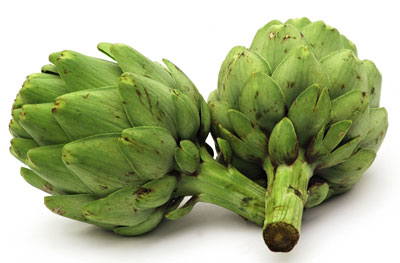 |
| Artichokes. Photo from wiki.com/healthyrecipes. |
By Cheryl A. Wixson
The impressive and mighty artichoke is actually the flower bud of a large thistle-family plant.
This delectable but formidable-looking vegetable dates backs for centuries and was prized by Romans as food of the nobility. Widely grown France, Italy and Spain, and California, Maine gardeners can also cultivate and enjoy artichokes.
To prepare whole artichokes for cooking, you need a solid cutting board, good sharp knife, shears and a large cooking pot. As aluminum and cast-iron discolor the flesh, a stainless steel or even glass pot works best.
First, grab the artichoke firmly by the top and, using your knife, slice off the stem and trim the base so that it sits flat. Then cut off 1 inch of the top. Rub the cut surfaces with half a lemon, or dip in lemon water to prevent discoloration.
Pull off the coarse, small leaves at the base and leaves that have major dings and scrapes. Using shears, trim off the sharp pointy tips of the remaining leaves. Wash the artichoke under cold running water until the leaves separate.
To cook, place the artichoke upside down on a steaming rack over boiling water and cook until a leaf comes out fairly easily when tugged. Depending upon the size, this could be about 30 to 45 minutes. If you don’t have a pot with a steaming rack, cook the artichokes right side up, monitoring carefully, in about 1 inch of water.
Whole artichokes can be enjoyed at any temperature, hot, room temperature, or chilled. The classic way is with Hollandaise sauce. My family particularly likes this rich, buttery sauce when prepared with duck eggs.
To eat an artichoke, pull off each leaf, one by one, and dip it into the sauce. Slide the leaf between your teeth. At the base of the leaf is the “meat.” Toss the leaf away and pull another. As you get closer to the middle, or the heart, the leaves will become quite tender, and quite good when eaten with extra sauce!
When the leaves are gone, a prickly, fuzzy, often purple mat (the choke) remains, covering the base. Scrape this choke away, and enjoy the large disk of purely edible, indescribably delicious heart of the artichoke.
Artichokes can also be stuffed, grilled, roasted, sautéed and fried. They are excellent added to pastas, soups and gratins.
In Maine, artichoke season, like asparagus season, is a luxury. If you grow your own artichokes, or are fortunate enough to have a good farming friend who cultivates them, try your hand at pickling the immature , secondary or smaller buds.
Marinated Baby Artichokes
Makes about four pint jars.
6 pounds baby artichokes
6 c. white vinegar
1 tsp. sea salt
1 tsp. whole black peppercorns
4 whole cloves
4 whole allspice berries
olive oil to cover
In a large, non-reactive cooking pot, combine the vinegar, salt and spices.
Trim the outer leaves, green leaf ends and stem ends from the artichoke, leaving just the tender, pale-green leaves. After each artichoke is prepared, drop it in the pot of vinegar. Bring the pot to a boil and cook the artichokes until tender, about 5 to 10 minutes. Drain and reserve the brine. Save the spices.
Distribute the spices evenly among the jars. Pack the artichokes in the jar, cover with brine, add enough olive oil to reach the fill mark of each jar and seal the jars.
Process for 25 minutes in a boiling water bath. Store in a cool, dry place for at least two weeks before opening. Store in the refrigerator after opening.
Cheryl Wixson is MOFGA’s organic marketing consultant. She cooks and eats in Stonington. Send questions, comments or notice of a bumper crop of artichokes to her at [email protected].
Growing Artichokes in Maine
Johnny’s Selected Seeds and Fedco Seeds sell artichoke seed.
Johnny’s has detailed directions for growing artichokes at www.johnnyseeds.com/Assets/Information/GlobeArtichokes.pdf.
Fedco says to start “seeds indoors in mid-February at warm temperatures (at least 60°) avoiding direct hot sun or overwatering (misting is preferred). Transfer after 6 weeks to a cold frame when outdoor temperatures stay above 25°. Keep as cool as possible over the next 6 weeks without going below 25°.”
Fedco also says, “Market gardener Alan LePage in Barre, VT, has gotten as many as eight fruits from a single plant. While that’s unusual, most plants will bear more than one, producing in the cooler fall weather that they prefer to summer’s full heat.”
We have seen artichokes overwintered in a small hoophouse at the Troy Howard Middle School in Belfast.
– Jean English
